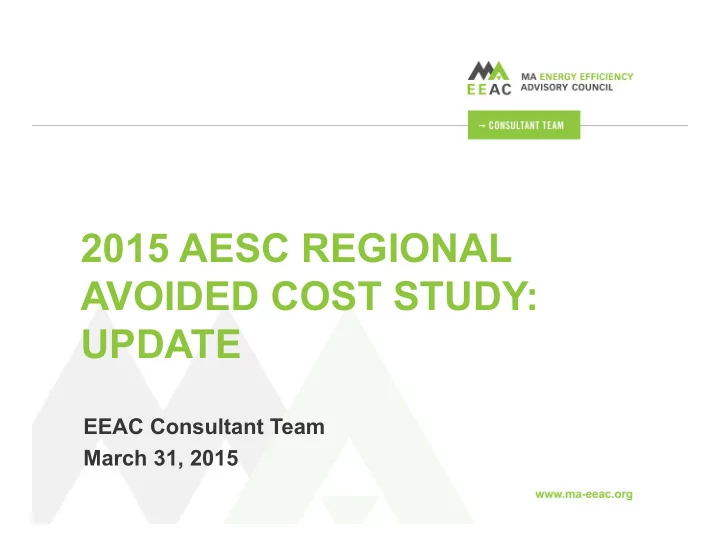

2015 AESC REGIONAL AVOIDED COST STUDY: UPDATE EEAC Consultant Team March 31, 2015
2015 AVOIDED COST STUDY (AESC) ► Avoided Cost Study (“AESC”) was finalized in March 2015 (received final report on Friday night, 3/27/15) ► Intended for use in the next three-year Plan, for 2016-2018 programs ► Developed through and prepared for the regional (six New England states) Avoided Energy Supply Component (AESC) study group; dozens of participants in the study group process ► AESC prepared regionally every three years (2013 AESC was the most recent prior study, which has been used for the 2014-2015 programs) ► Based on updated market prices and forecasts ► New contractor (TCR), models, and assumptions for the 2015 AESC study www.ma-eeac.org 2
EXAMPLE CALCULATION OF BENEFITS Benefits = net savings * avoided costs 9.215 kW electricity $50 per kW electric capacity 13,823 kWh electricity $0.08 per kWh electric energy 0 mmbtu natural gas $10 per mmbtu natural gas 0 mmbtu other fuel $13 per mmbtu other fuel 0 gallons water $0.01 per gallon water 0 units non-resources $(variable) per units non-resources Year 1 benefits = (9.215 * $50) + (13,823 * $0.08) + ($10 * 0) + ··· = $1,566.59 The benefits are calculated for each year of the widget life and present valued using a discount rate to determine lifetime benefits www.ma-eeac.org 3
SUMMARY: IMPACTS OF 2015 AVOIDED COST STUDY FOR MASSACHUSETTS ► The AESC study estimated lower avoided costs for most (but not all) values compared to what we have been using for 2015 EE programs ► For MA, the electric avoided costs are about 15% lower ► For MA, the gas avoided costs are probably also about 15% lower – but some gas programs are closer to the margin of cost-effectiveness, plus there are EM&V results ► One significant driver: the forecasts of lower natural gas market prices plus the forecasted construction of new gas pipelines in the region lead to long term lower avoided costs for gas and also drive lower electric avoided costs ► Another significant driver: the significant reduction in estimates of DRIPE (price effects due to EE programs) ► The PA are doing/updating some calculations and analysis www.ma-eeac.org 4
MAJOR DRIVER: CHANGES IN GAS MARKET PRICES www.ma-eeac.org | 5
CHANGES IN ELECTRIC AVOIDED COSTS www.ma-eeac.org | 6
APPLICATION OF 2015 AVOIDED COST STUDY IN MASSACHUSETTS ► AESC is a regional study, but each state decides how to apply the study results in its state, and which values to apply ► Stay tuned for more information on the effects of the 2015 AESC values on Massachusetts EE programs (PA analysis and EEAC consultant review is ongoing) ► The PAs are doing/updating some calculations and analysis in advance of applying the 2015 AESC avoided costs to be used in the April 30 th draft Plan ► STAY TUNED FOR UPDATE IN MAY www.ma-eeac.org 7
Recommend
More recommend